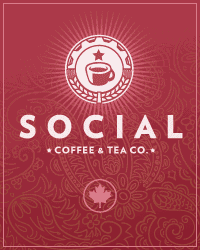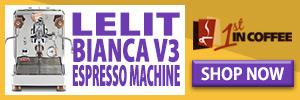I was doing some research for my thesis when I happened to stumble upon a full half page article in the New York Tribune from July 1918 about one of my favorite subjects: coffee. What really caught my eye was the image of a siphon coffee brewer, so I gave the article a read.
Imagine my surprise to find out that in 1918, a mainstream press article was recommending many of the same things CoffeeGeeks recommend for brewing good coffee!
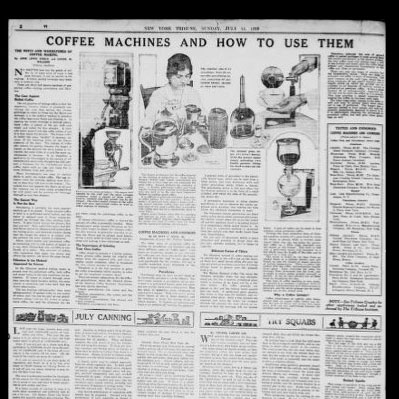
There was solid advice about owning a grinder and only grinding fresh. This got me thinking: If experts have been recommending this for over 100 years, why hasn’t this simple concept about great coffee caught on with the masses?
There was also some serious advice about why boiling coffee was bad, and why percolators are bad as well for good tasting coffee. But the really interesting part about this article for me at least was the focus on siphon coffee brewer – and specifically, siphon coffee makers in a US mainstream newspaper article almost 100 years ago.
I don’t know too many people who know more about siphons and their history than Mark Prince – the guy running this website. He is so into siphons, he even did a two part podcast on the history of them. I asked him about when siphon brewers first came to America.
The earliest reference I’ve found to the siphon coffee brewer in the US was an article in a New York newspaper talking about a ‘double glass ball’ coffee brewing device brought over from France. This was in the 1890s. Silex patented their safety glass and a design for the siphon coffee brewer around 1914, and I believe they had them for sale on the market around 1917, though with the Great War going on, they probably didn’t make many of them.
Mark Prince, siphon nerd
This article I found dates back to July 1918, and I’m guessing siphons were a brand new thing for people. The latest high tech gizmo of its age.
One thing I noticed in the photographs with the article was something I don’t think any siphon brewer today even has as a feature: the 1918 Silex siphon pictured can actually tilt sideways on its stand for pouring. What a cool feature!
All the advice in this article is great, save for one bit: they recommend that, for stronger after-dinner coffee, you can heat and reheat the siphon brewer – drawing the brewed coffee down, then reapplying heat to send the brew back up to the grounds. And repeat. Pretty bad advice! But otherwise, much of the advice doled out in 1918 is just as valuable advice today.
I’ve also included a sidebar this article had, featuring recommended prices and equipment to consider buying. I’ve included it for several notable reasons. First, notice all these appliances are made in the USA! It’s almost impossible to think of a time when every appliance and machine you bought for your home and work was made in this country.
Secondly, notice the prices. When you think that a 1918 dollar is worth about sixteen of today’s dollars, it puts some of these prices into perspective. Silex Siphons ran from $5 to $25 at the time, depending on the fanciness of the machine and if you bought an electric one or a alcohol-fuel one. $25 back then is about $400 today – I can’t think of any siphon setups that cost that much today – which means today’s siphon buys are a pretty good deal, all things considered!
Here’s the article, in full, including recommended machines and grinders to buy (and their 1918 prices).
Coffee Machines and How To Use Them
The Whys and Wherefores of Coffee Making
By ANNE LEWIS PIERCE and LOUISE M. WILLIAMS
Tribune Institute
NO MATTER how fine the grade of coffee is, or what kind of roast it has gone through, it can be spoiled in the making. A bitter, muddy beverage may mean only a careless cook. There are three well known method of preparing coffee: boiling, percolating and filtering.
The Case Against Boiled Coffee
The old practice of boiling coffee is fast disappearing, because science is gradually convincing the cook that boiling the coarser grindings in order to bring out the flavor and strength is a far inferior method to grinding the coffee bean more finely and filtering it. In making the boiled beverage a medium granulated coffee is placed in the pot with cold water and boiled for five minutes. A little cold water poured into the coffee, settles it and it is then ready for serving.
The longer coffee is boiled the more “muddy” it becomes, because of the breaking down of the fibrous material of the bean. The boiling of coffee also lowers its quality, because the longer it stands on the grounds the more tannin is extracted, the more bitter it is and the more unwholesome it becomes. It is. therefore, a method to be discouraged in the opinion of all chemists and most cooks, though some still protest a fondness for the old-fashioned boiled coffee, made with an egg and claim for it more richness, body and aroma.
Many housekeepers use eggs or crushed shells to settle the boiled coffee. The egg albumin coats the grounds, making them heavier, so that they will sink to the bottom. This custom does not improve the flavor at all, and the clearing can be more easily accomplished by cold water and by pouring the beverage through a very fine strainer.
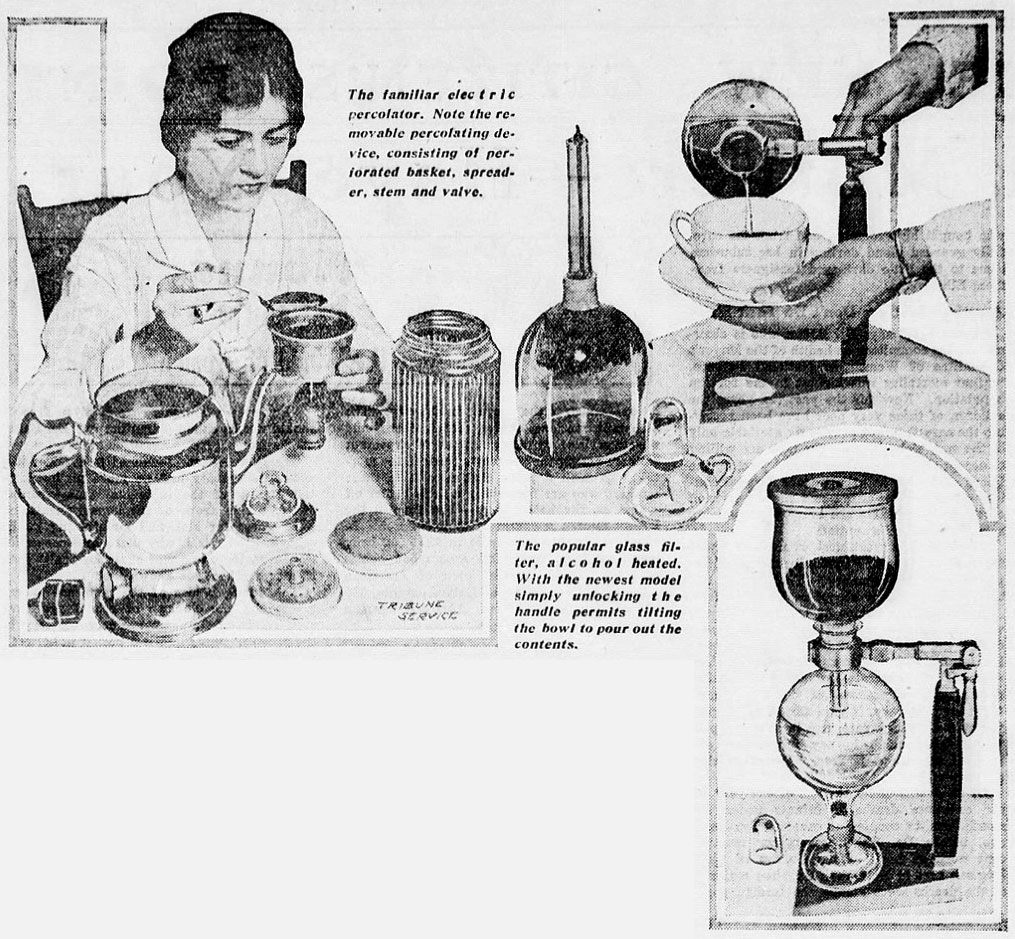
The Easiest Way Is Not the Best
Percolating is probably the most popular method, as it is easiest. Finely ground coffee is held in a perforated metal basket, and the water is sprayed over it, being repeatedly pumped up through the tube, starting lukewarm. It gets hotter during the process, but does not boil. Most authorities agree that the best flavor cannot be obtained with water below the boiling point, and chemical analysis shows that the longer the water is in contact with the grounds the more tannin is extracted.
Aborn quotes boiled and percolated coffee as containing 2.21 to 2.90 grains of tannin to a cup, while filtered had only one-fifth to one-fourth of a grain. The amounts of caffein (the ingredient that keeps you awake and affects the nerves) are about the same for all.
Filtration Is the Method Approved by Science
In the filtration method boiling water is poured over the pulverized coffee, both coffee and water being in the best conditions for extraction. If water is poured through more than once the liquid becomes darker, but more tannin is extracted, and some hold that the flavor deteriorates.
Use one heaping tablespoonful (two level tablespoonsful) of ground coffee to one cupful of water, and “one for the pot,” as our grandmothers always told us, for boiled or percolated coffee, but omit the allowance for the pot when using the pulverized coffee in the filter.
If strong after-dinner coffee is desired the amount of coffee is generally doubled. Many housekeepers make several filtrations or boil the coffee longer to obtain the stronger coffee, but this practice is generally conceded to debase the flavor and to extract more tannin, giving a more acrid or bitter taste to the beverage and making it less wholesome as well.
The Importance of Grinding Your Own Coffee
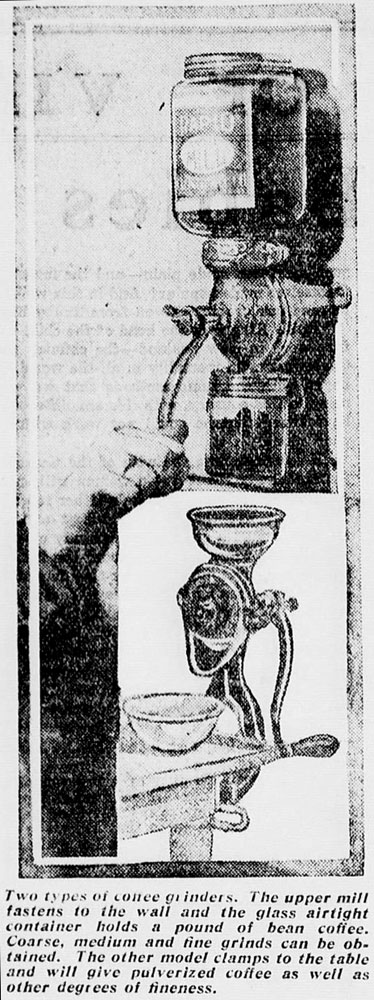
Coffee should be ground just before making. When ground coffee stands the volatile oils escape from the ruptured cells, and even a tightly sealed container, while it minimizes the loss, cannot prevent it entirely.
Therefore it is the best practice to grind the coffee immediately before making, in order to get the maximum aromatic flavor.
There are certain comparisons for the different granulations, which Mr. Edward Aborn of the National Coffee Roasters’ Association has very clearly described:
- Coarse granulations, like coarse and fine hominy.
- Medium granulations, like coarse and fine granulated sugar.’
- Pulverized granulations, like ground and bolted cornmeal.
- Powdered granulations, like flour.
The degree of fineness for the coffee depends on the method of preparing it. Some housekeepers believe that coarse granulation and boiling for a short time are two essentials for good coffee. Science declares the contrary is true. A freshly pulverized coffee and fresh rapidly boiling water passing over the grounds once are held to be the two most important factors in making good coffee.
It is difficult to give any hard and fast rules in coffee making for two reasons: First, the matter of personal taste plays a large part: one man’s favorite coffee does not suit the next man at all; and a coffee that is excellent with cream may not be a satisfactory brew to serve black.
Again, many factors enter into the problem and interact on each other. If is conceded that “good coffee” depends almost equally on the grade and kind of coffee used, the roast and the method of making the beverage.
COFFEE MACHINES AND GRINDERS
By DE WITT V. WEED, JR.
Engineering Expert, The Tribune Institute
The three ways of preparing coffee by boiling, by percolation and filtration call for three different types of “coffee pots.” Coal range or electricity, alcohol or gas will heat the coffee pot, but those who prefer the boiled coffee will find the coal or gas range the most practicable for this method. The pot is usually enamelled ware, aluminum or tin, nickel or copper plated.
Percolators
Percolators may be used on any stove or be electrically operated or alcohol heated. The stove types contain a percolating device consisting of a perforated basket, stem and valve and are usually fitted with a glass cover. They are made of enamelled ware, aluminum or nickel-plated copper. With cold water percolation begins in two to three minutes, and the beverage is ready for serving inside of fifteen minutes. It requires no attention and there is no problem of “settling the grounds.”
A popular form of percolator is the electrically heated type, which can be used from a lamp socket, and even beginning with cold water percolation starts within a minute. The percolating device is like any other, but the heating element is in the form of a small cylinder, over which the stem of the percolating device fits.
A precaution necessary in using electric percolators is not to immerse the entire appliance when washing, thus wetting the base where the electrical connection is made.
The Universal electric percolators are fitted with a safety device which automatically breaks the electric circuit when the water has boiled off and the appliance itself is becoming heated to a temperature which would injure it. In this way an expensive machine is protected from the certain ruin that would result from such forgetfulness.
The urn style of percolator, which is more attractive and graceful in design than the pot type, operates similarly, but is larger in capacity.
Different Forms of Filters
The filtration method of coffee making can be carried out in the coffee pot on. the stove, or there is a small device which fits over the cup and gives an excellent concoction if briskly boiling water is poured over the grounds held in it.
The Marion Harland Coffee Pot, using the filtration principle, looks like any straight sided pot, but has a narrow cylindrical inset, which is covered at its lower end by a fine wire screen. The coffee grounds are placed in this and the boiling water poured into the inset. A perforated plate permits this water to drip onto the grounds, and extraction takes place. Only a few minutes are required, and when the water has dropped through the grounds the inset should be removed so that the beverage will not become bitter. A pint of coffee can be made in four minutes, using powdered coffee.
Perhaps the most attractive form of filtering machine consists of a glass bowl in which the water is placed, while a covered glass funnel fitted into the top holds the pulverized coffee on a filter cloth stretched over the mouth of the funnel. This cloth is tied over a perforated metal disk mounted on a rod which runs the length of the tube and is secured by a wing nut.
The water is boiled by the heat from an alcohol flame or a radiant electric unit and forced up into the funnel by steam pressure at boiling temperature. There it comes into contact with the coffee, and extraction rapidly takes place. Upon removing the lamp the beverage flows downward into the bowl, and is ready to serve unless greater strength is desired. It can be sent upward two or three times by reapplying the heat.
This type of coffee machine is very popular because it is sanitary, a delicious drink of maximum wholesomeness and deliciousness is produced, and the whole process can be easily carried out at the dining table.
Why a Coffee Grinder?
Coffee deteriorates so quickly after being ground that an expert coffee tester can detect the loss of flavor and aroma that takes place with one day intervening between the grinding and brewing.
Therefore, although the sale of ground coffee in sealed packages is large among those who prefer convenience to the perfect product the real coffee lover will always have a mill in the kitchen and insist upon the coffee being ground and transferred immediately to the coffee pot, filter or percolator.
There are only two types of grinders for the housewife’s choice. They are alike in principle, but differ in style of mounting. The most common is the wall type, which has a glass container of one pound capacity and a simple device by which the grinder can be adjusted to all degrees of fineness except a pulverized or powdered coffee. It has a glass marked off in tablespoonsful, supported below the mill to catch the coffee as it is ground. This type provides a sealed container for keeping the coffee in the bean until used.
The other type either clamps to the table or wall and may be quickly taken down when not in use, if preferred. The hopper has a capacity limited to four ounces, and only the quantity immediately required is placed in it. It is particularly designed for pulverized or powdered coffee, but will give other grindings as well.
TESTED AND ENDORSED COFFEE MACHINES AND GRINDERS
Coffee Pots and Percolators (stove type)
Aluminum
- Aladdin. Prices, $2-$3. The Cleveland Metal Products Company, Cleveland.
- Monarcast. Prices, $3-$4. Monarch Aluminum Ware Company, 4613 Payne Avenue, Cleveland.
- Universal. Prices. $3-$5. Landers, Frary & Clark, New Britain, Conn.
- Wagner. Prices, $3.50-$5. Wagner Mfg. Co., Sidney, Ohio.
- Wear-Ever. Prices, $2-$3. The Aluminum Cooking Utensil Company, New Kensington, Penn.
- West-Bend. Price, $3.50. West Bend Aluminum Company, West Bend, WTis.
Enamel
- Lisk. Lisk Manufacturing Co., Canandaigua, N. Y.
Percolators (electric)
- Hotpoint. Prices, $9-$ 15. Hotpoint Electric Heating Company, 147 Waverly Place, New York.
- Universal. Prices, $8.50-$18.50. Landers, Frary & Clark, New Britain, Conn.
- Westinghouse. Prices, $8-$13. Westinghouse Electric Manufacturing Company, 165 Broadway, New York
Filters (siphons etc)
- Filtrola (alcohol). Prices, $5-$10. Crystal Percolator Company, Inc.,
44-60 East 23d Street, New York. - Marion Harland (pot type). Prices, $2-$4. Silver & Co., 304 Hewes Street, Brooklyn, N. Y.
- Silex (alcohol and electric). Prices, $5-$25. The Silex Company, 45 High Street, Boston.
Coffee Grinders
- Crystal. Price, $1.50. Arcade Manufacturing Company, Freeport, 111.
- Enterprise No. 100. Price $1.50.
- Enterprise No. 0 and 00 (pulverizer). Price, $2.50. Enterprise Manufacturing Company, New York.
- Rapid. Price, $1.25-$ 1.50. Culinary Manufacturing Company, 273-277 Livingston Street, Newark, N. J.
The entire original article (in the public domain) can be found here.



